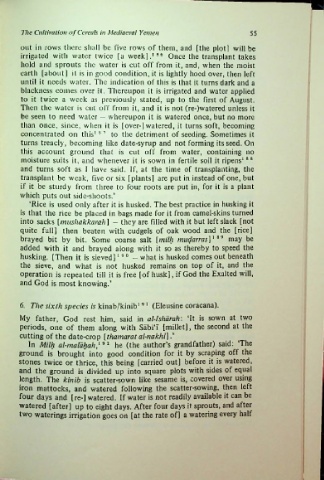Page 69 - Arabian Studies (I)
P. 69
The Cultivation of Cereals in Mediaeval Yemen 55
out in rows there shall be five rows of them, and [the plot] will be
irrigated with water twice [a week], 1 8 6 Once the transplant takes
hold and sprouts the water is cut off from it, and, when the moist
earth [about] it is in good condition, it is lightly hoed over, then left
until it needs water. The indication of this is that it turns dark and a
blackness comes over it. Thereupon it is irrigated and water applied
to it twice a week as previously stated, up to the first of August.
Then the water is cut off from it, and it is not (re-)watered unless it
be seen to need water — whereupon it is watered once, but no more
than once, since, when it is [over-] watered, it turns soft, becoming
concentrated on this1 8 7 to the detriment of seeding. Sometimes it
turns treacly, becoming like date-syrup and not forming its seed. On
this account ground that is cut off from water, containing no
moisture suits it, and whenever it is sown in fertile soil it ripens 1 8 8
and turns soft as I have said. If, at the time of transplanting, the
transplant be weak, five or six [plants] are put in instead of one, but
if it be sturdy from three to four roots are put in, for it is a plant
which puts out side-shoots.5
‘Rice is used only after it is husked. The best practice in husking it
is that the rice be placed in bags made for it from camel-skins turned
into sacks [mushakkarah] — they are filled with it but left slack [not
quite full] then beaten with cudgels of oak wood and the [rice]
1 8 9
brayed bit by bit. Some coarse salt [milh mudarras] may be
added with it and brayed along with it so as thereby to speed the
husking. [Then it is sieved] 1 9 o - what is husked comes out beneath
the sieve, and what is not husked remains on top of it, and the
operation is repeated till it is free [of husk], if God the Exalted will,
and God is most knowing.5
6. The sixth species is kinab/kinib 1 9 (Eleusine coracana).
My father, God rest him, said in al-Isharah: ‘It is sown at two
periods, one of them along with Sabi‘1 [millet], the second at the
cutting of the date-crop [thamarat al-nakhl].’
In Milh al-malahah,1 9 2 he (the author’s grandfather) said: ‘The
ground is brought into good condition for it by scraping off the
stones twice or thrice, this being [carried out] before it is watered,
and the ground is divided up into square plots with sides of equal
length. The kinib is scatter-sown like sesame is, covered over using
iron mattocks, and watered following the scatter-sowing, then left
four days and [re-] watered. If water is not readily available it can be
watered [after] up to eight days. After four days it sprouts, and after
two waterings irrigation goes on [at the rate of] a watering every half

